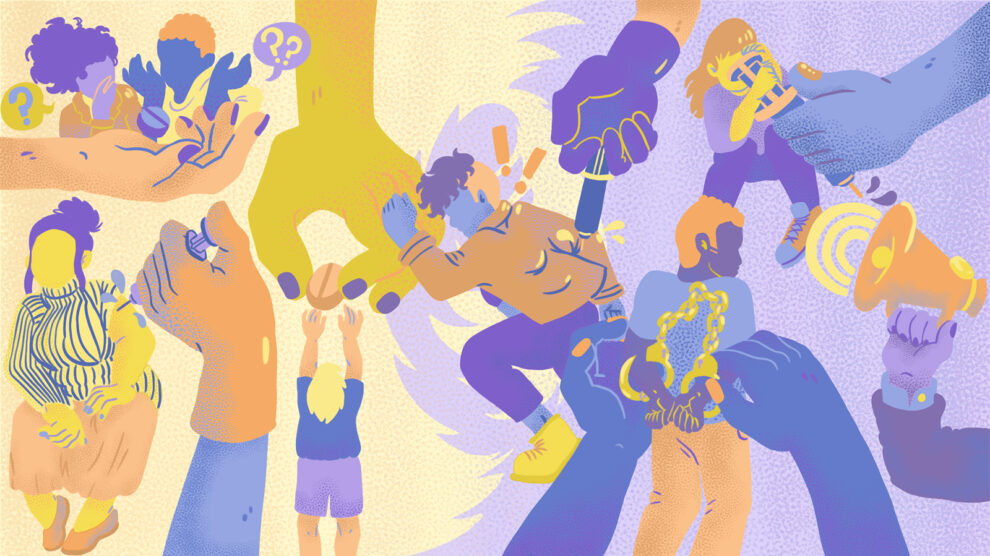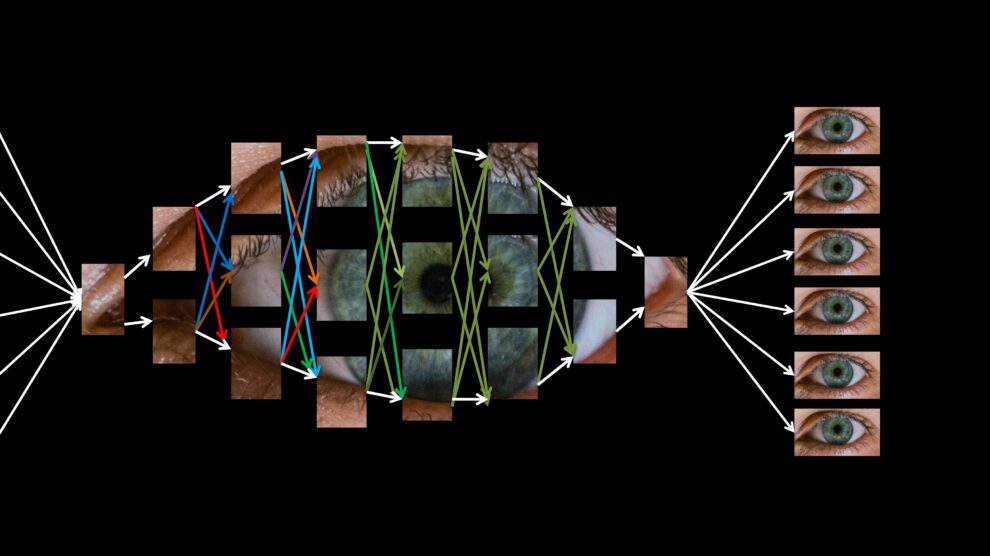Psychology and Neuroscience Beyond the Binary
By Giulia Barsuola
Volume 22, number 2, Envisioning and Enacting the Science We Need

Biological essentialism and reductionism have plagued how we scientists do science, and how society looks at the science we do, for a very long time. Biological essentialism refers to the idea that who we are is purely innate, a hardwired “essence,” rather than the result of myriad factors including culture and upbringing. The closely related approach of “biological reductionism” tries to explain social and cultural phenomena solely in terms of biology, and a rather narrowly defined version of biology at that.
As somebody who has been immersed in the humanities for a long time, I do not have much sympathy for either of these two concepts. Science can and should do better than to rely on essentialist ideologies. As a nonbinary queer pansexual cognitive neuroscientist, I am passionate about LGBTQ+ and mental health activism and the intersection of the two. I believe that people have the right to ask themselves who they are, to become who they are, and to be welcomed and respected by others around them. How I wish we all agreed on this.
A recent survey, “Exploring the Workplace for LGBT+ Physical Scientists,” conducted in the UK by The Institute of Physics, Royal Astronomical Society, and Royal Society of Chemistry, revealed that 28 percent of the respondents had considered leaving their workplace at some point because of discrimination. Trans and nonbinary scientists were most likely to consider leaving their academic posts, with a fifth of them saying that they regularly considered quitting.1 This is a huge number we cannot ignore. There are concrete steps that academics and workers in STEM fields can take to foster an inclusive environment for trans and nonbinary academics and help to change the transphobic atmosphere in academia. Here in the UK, we are lucky to have amazing organizations devoted to promoting diversity in science, such as Pride in STEM, led by Dr. Alfredo Carpineti (Imperial College London). Still, many universities and many professors deny gender non-conforming scientists the respect they afford to their cis peers.
When I log on to Twitter, each day I encounter ever-new hate trends spread by a group of trans-exclusive people–far too many. “Trans-exclusive” means dedicated to spreading a message of hate and exclusion against transgender and nonbinary people. Subgroups of second wave feminism are particularly hostile toward transgender people: they oppose transgender rights, deny that trans women are women, and block trans women from accessing women’s spaces. Ironically, these people called themselves “radical” when nothing is radical about hate, and “feminists” when nothing is feminist about exclusion: they are sometimes called Trans-Exclusionary Radical Feminists, or TERFs.2 Trans-exclusionary people are in our universities, in our departments, in our labs. They occupy positions of power and they are abusing this power. We trans and nonbinary academics can hardly be expected to feel welcomed or safe in departments where those in positions of power over us publicly express a wish not to have to interact with us.3
On June 15, 2019 the Sunday Times published a letter signed by Professor Kathleen Stock and thirty-four academics from various universities across the UK.4 These academics, from fields including neuroscience and psychology, lamented the collaboration between UK universities and the LGBT charity Stonewall UK, especially attacking Stonewall UK’s Diversity Champions Programme, devoted to foster trans and nonbinary inclusivity. In the letter, these trans-exclusive academics affirm their supposed right to question, challenge, and ultimately refuse students’ gender identities and pronouns. They deny that trans women can be lesbian (because according to them trans women are not women, therefore cannot be lesbian), and they oppose the presence of trans women in women’s spaces like restrooms and sports teams. A counter-letter organized by the University of Sheffield’s Dr. Caroline Dodds Pennock was co-signed by more than six thousand academics around the world.5 We don’t need to calculate a p-value to determine which letter received more support.
Stonewall UK is a vital and life-saving charity. Named after the 1969 Stonewall riots in New York City, Stonewall was founded in 1989 by activists fighting against Section 28, legislation preventing what was labelled as “promotion” of homosexuality in schools. For the past thirty years Stonewall UK has been campaigning for “acceptance without exception” for every part of the LGBTQ+ acronym, not only for the letters L, G, and B. Stonewall UK also shares data about LGBTQ+ people in the UK in order to inform policy and promote necessary changes in the workplace, universities, and society as a whole. In its “LGBT in Britain – Trans Report” in 2017, Stonewall reported that “two in five trans people and three in ten nonbinary people have experienced a hate crime or incident because of their gender identity in the last twelve months, two in five trans people said that healthcare staff lacked understanding of specific trans health needs when accessing general healthcare services in the last year.”6 When it comes to academia, “more than a third of trans university students in higher education have experienced negative comments or behaviour from staff in the last year and one in seven trans university students have considered dropping out or have dropped out of a higher education course because of experiencing harassment or discrimination from students and staff in the last year.” Yet, there are professors and department directors who believe that they have a moral imperative to challenge our existence and to undermine our rights. These academics attempt to dissect our identities, claim we are delusional, misgender us, and attempt to act as gatekeepers in gendered spaces. As stated in the Sunday Times letter and in another letter published in Inside Higher Ed, these academics claim to be doing all this in the name of academic freedom. I believe that academic freedom does not mean you can harass trans and nonbinary people unconditionally.7 Instead, I believe people should begin to consider the concept of “academic responsibility,” as the letter “On Philosophical Scholarship of Gender: A Response to ‘12 Leading Scholars’” highlights: “we do, however, think it is important, when exercising our academic freedom, that we consider how our views may impact others. Academic responsibility requires us to consider differences of power and vulnerability in speaking of and to others and the effects of our words in reinforcing structures of oppression.”8
The same trans-exclusionary academics and scientists claim to be “gender critical”: they deny the existence of gender, reducing the richness of gender expression to people’s genital anatomy. According to these academics, biology is destiny once again, but there has never been anything radical nor feminist about this old claim. Biology is not destiny, it never has been and never will be.9 Biology does not determine identity. The point is not to deny the existence of gender: gender does exist. If you look around you, you can observe that gender is performed every minute by the vast majority of humans around you. In order for trans people to have true equality, we must move beyond the harmful and regressive gender binary that society imposes on us since even before we are born. We must create a radical new way of existing as human beings, not as women and men nor as females or males. The point is to make the concepts of gender and sex obsolete. “You never change things by fighting the existing reality. To change something, build a new model that makes the existing model obsolete,” to quote Richard Buckminster Fuller.
My activism is focused on advocating for the need to move beyond the dualism created by thinking about gender as either/or. Dividing the world into male/men and female/women has limited the potential and constrained the behaviour of every human, not just trans and nonbinary individuals. Elaborating on this men versus women dualism from a Marxist point of view, Monique Wittig wrote:
The class struggle is precisely that which resolves the contradictions between two opposed classes by abolishing them at the same time that it constitutes and reveals them as classes. The class struggle between women and men … is that which resolves the contradictions between the sexes, abolishing them at the same time that it makes them understood.10
Almost forty years ago, Witting was already advocating for a sexless and a genderless society. What we see today–denying the existence of gender beyond biology (as these gender-critical/trans-exclusive academics are doing) but insisting on the supposed existence of two groups of people “fundamentally different” because of their biology–is neither liberating nor true.
Psychology has shown for decades that the gender binary is imposed by the society we live in, and is then reflected in our behaviors, preferences, choices, and beliefs, and ultimately in our cognitions and in our brains.11 There is a constant interplay between the biological and the social domain so that, as Anne Fausto-Sterling further emphasizes, “components of our political, social, and moral struggles become, quite literally, embodied, incorporated into our very own physiological being.”12 Gender is not only culture, sex is not only nature: they are both “naturecultures,” as Donna Haraway would put it. The point now is to create a world where gender and sex are not salient or deterministic.
Biases leading to inequalities arise precisely when gender or sex are made salient. A number of social psychology experiments have illustrated that manipulating the relevance of gender influences behaviors: reminding people of their gender triggers maladaptive stereotypes and assumptions that inevitably undermine one’s performance on specific tasks, for example girls performance in math tests.13 We live in a society of gender-reveal parties, where expectations are set for us even before birth. These expectations are reproduced at a systemic level. This is also the reason why, even those parents most enthusiastic about gender-neutral parenting struggle not to place gender-based expectations on their children.14 Gender-neutral parenting often fails not because biology is destiny, but because we are constantly immersed in a society where gender and sex are constantly affirmed outside the home. Systemic problems need systemic changes, not just individual changes.
A first step toward systemic change is to acknowledge that gender and sex are not binary concepts. Expanding our worldview beyond the binary can happen once we realize that the gender/sex binary system is hurting all of us. Some of us already refuse the binary altogether: call us nonbinary or genderqueer. The term nonbinary “describes any gender identity or expression outside the categories of male and female.”15 Our identity is valid and deserves to be respected as any other identity. Our existence is not up for debate. Nonbinary identities are not new, nor are they exclusively a Western phenomenon. These identities have always existed, both within and outside of the western world: the Italian femminielli in the nineteenth century, the Hijira community in South Asia, and Indigenous identities in pre-colonial Africa are some examples that the nonbinary performer Travis Alabanza has observed.16 Other examples are Two-Spirit people in Indigenous communities in North America and Fa’afafine people in Samoan culture.
Now, the problem is that, if we keep doing research as if nonbinary people did not exist, we will not produce research that is ecologically valid, that survives when applied to the world outside the lab. This is especially true for disciplines like psychology and neuroscience. Women do not come from Venus, men do not come from Mars. We all come from the same planet Earth. How revolutionary! With analysis beyond the binary, there is no Venus, no Mars–and no other binary structure–that may be brought in here to justify pernicious assumptions, to perpetuate society’s inequalities, to sugar-coat the binary ideology, to preserve the status quo. Moving beyond the binary in society can start with changing how we do research and the questions we ask within science. Why do we continue to focus on the differences between the “female” brain and the “male” brain, when these concepts have been repeatedly debunked?17 Why not change the question? There are so many important and truly useful scientific questions that are worth asking, investigating, and funding. If you still believe that a question about the difference between women and men on specific tasks and in specific contexts is worth asking, then you might wish to check where you place the causality. As Cordelia Fine pointed out, “one-way arrows of causality are just so last century. The circuits of the brain are quite literally a product of your physical, social, and cultural environment, as well as your behaviors and thoughts.”18 The differences we see in brain structures or in those different behaviors are not the result of fundamental biological differences between men and women, but are the effects of how society wants us to behave.
The American Psychological Association (APA) Division 44, The Society for the Psychology of Sexual Orientation and Gender Diversity, provides useful information for psychologists, neuroscientists, and clinicians:
Given the underrepresentation of nonbinary gender populations in the literature, it is critical that psychologists add to the empirical base of information. Research questions about gender and gender identity should include options beyond “male,” “female” …. Asking specifically about more common nonbinary identities such as genderqueer and gender fluid … allows for accurate information about client’s current gender identity.
Additionally, it is important for future research to take an intersectional approach to understanding the complexity and nuance of nonbinary gender identities in diverse population groups … It is important to continue to develop research methods, including sampling and measurements, to attend to the lived experience of diverse nonbinary people.19
Psychologists and neuroscientists, we need to pay attention to the questions we are asking and the way we interpret our results, especially when those results influence social attitudes.20 In so doing, we can begin to make space for nonbinary and trans people in our departments as colleagues, in our studies as participants, and as comrades in our lives. A more inclusive and informed science is a better science. A more inclusive science is the only possible science for the people. A science for and by all of us, beyond the categories of gender and sex.
Here are some steps to make science and scientific departments more inclusive:
- Do you need to ask about gender in the demographic forms of your studies? If you do, provide a third gender option (like “other” or “nonbinary” or “fill-in-the-blank”).
- Do you need to ask about titles in your demographic forms? If yes, provide the gender neutral title Mx.
- There are several gender neutral pronouns. The most common one is the singular they. Try incorporating the singular they/them in your speech.
- If you don’t know someone’s pronouns, use gender neutral ones, like the singular they to avoid making assumptions and misgendering. If you hear others being misgendered, speak up.
- Ask about people’s pronouns during lab meetings, events, conferences. Put your name and your pronouns on conference badges. Include your pronouns in your email signature.
- Campaign at your workplace to include gender-neutral restrooms in any new building plans, or convert some existing restrooms into gender-neutral spaces. Make at least some restrooms in your department gender neutral. If your department is planning to build new spaces, make sure the restrooms there are all gender neutral single occupancy toilets.
- If gender is a significant component of your research, think about collaborating with a gender studies scholar.
- If you are a clinical psychologist, a psychotherapist or a counsellor, learn more about gender identity, and think about how you can adopt the language and practices above.
To learn more about current research exploring the topic of sex, gender, and neuroscience, check out these papers:
-
- Recommendations for sex/gender neuroimaging research: key principles and implications for research design, analysis, and interpretation, Gina Rippon at al., 2014.
- Journal of Neuroscience Research Policy on Addressing Sex as a Biological Variable: Comments, Clarifications, and Elaborations, Gina Rippon at al., 2017.
- Neurofeminism and feminist neurosciences: a critical review of contemporary brain research, Schmitz and Hoeppner, 2014.
- Gender on the Brain: A Case Study of Science Communication in the New Media Environment, O’Connor and Joffe, 2014.
- Neuroscience in the Public Sphere, O’Connor at al., 2012.
Acknowledgements
GB wishes to dedicate this article to the memory of Aleix Gorchs Rovira and to thank Tyler Rhinesmith for his help with editing.
About the Author
Giulia Barsuola is a PhD student in Cognitive Neuroscience at the MRC Cognition and Brain Sciences Unit, University of Cambridge, UK. Giulia holds an undergraduate degree in Philosophy and a Master of Science in Cognitive Science. They studied and did research in six countries across three continents, but UC Santa Cruz is what they miss the most. They are passionate about LGBTQ+ and mental health activism. They are a booklover and an avid reader of William Blake and Anne Carson.
References
- Jennifer Dyer, Angela Townsend, Sheila Kanani, Philippa Matthews, Ale Palermo, “Exploring the Workplace for LGBT+ Physical Scientists,” Institute of Physics, Royal Astronomical Society and Royal Society of Chemistry, June 2019.
- Leela Ginelle, “Trans Women Are Women. Why Do We Have to Keep Saying This?” Bitch Media, June 9, 2015; The term “TERF” originated within the 1970s radical feminist movement. See Katelyn Burns, “The rise of anti-trans ‘radical’ feminists, explained,” Vox, September 5, 2019.
- TL Jordan, “What I wish people understood about being a trans scientist,” ASBMB Today, October 1, 2019.
- Nick Duffy, “After 30 academics sign letter opposing trans rights, 3600 sign letter in support,” PinkNews, June 18, 2019.
- See the letter here: https://docs.google.com/forms/d/e/1FAIpQLSffvD647-ujyDwA9J7WaopjNDsBSZ1YxZIcrrlmZWDmq08Jnw/viewform
- Chaka L. Bachmann and Becca Gooch, “LGBT in Britain Trans Report,” YouGov and Stonewall (2017): 5-6
- 12 Leading Scholars, “Philosophers Should Not Be Sanctioned Over Their Position On Sex and Gender,” Inside Higher Ed, July 22, 2019.
- “On Philosophical Scholarship of Gender: A Response to ‘12 Leading Scholars,’”Blog of the APA, August 7, 2019.
- Biology as a Social Weapon, eds. Douglas Boucher, Kathryn Dewey, Robert Noonan, Steven Risch, Scott Schneider, Jean Stout, and John Vandermeer of the Ann Arbor Science for the People Editorial Collective (Minneapolis: Burgess Publishing Company, 1977).
- Monique Wittig, “The Category of Sex” in The Straight Mind and Other Essays (Boston: Beacon Press, 1992).
- Cordelia Fine, Delusions of Gender: the Real Science behind Sex Differences (London: Icon Books, 2012); Cordelia Fine, Testosterone Rex: Unmaking the Myths of Our Gendered Minds (London: Icon Books, 2017); Gina Rippon, The Gendered Brain: the New Neuroscience that Shatters the Myth of the Female Brain (London: Bodley Head, 2019); Daphna Joel, Luba Vikhanski, Gender Mosaic: Beyond the Myth of the Male and Female Brain (New York: Little, Brown Spark, 2019).
- Anne Fausto-Sterling, Sexing the body: gender politics and the construction of sexuality (New York: Basic Books, 2000), quoted in Fine, Delusions of Gender.
- Fine, Delusions of Gender.
- Fine, Delusions of Gender.
- Sally Hines, Is Gender Fluid? A Primer for the 21st Century (London: Thames & Hudson, 2018).
- Travis Alabanza, “Non-Binary People Aren’t a New Phenomenon – We’ve Been Here As Long As Humans Have Existed,” HuffPost UK, last updated December 5, 2018.
- Rippon, The Gendered Brain.
- Fine, Delusions of Gender.
- Arielle Webb, Emmie Matsuno, Stephanie Budge, Mira Krishnan, and Kimberly Balsam, “Non-Binary Gender Identities Fact Sheet,” APA Division 44, American Psychological Association, 2015.
- Fine, Delusions of Gender.





